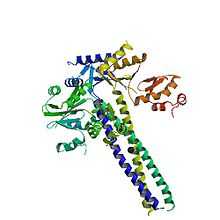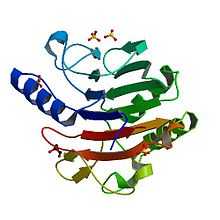Long interspersed nuclear element
Long interspersed elements (LINEs) are a group of non-LTR (long terminal repeat) retrotransposons which are widespread in the genome of many eukaryotes.[1]
History of discovery
The first description of an approximately 6.4 kb long LINE-derived sequence was published by J. Adams et al. in 1980.[2]
Types of LINE elements
The LINE-1/L1-element is the only element that is still active in the human genome today. It is found in all mammals.[3] However, remnants of L2 and L3 elements are also found in the human genome.[4]
Structure
A typical L1 element is approximately 6,000 base pairs long and consists of two non-overlapping open reading frames (ORF) which are flanked by UTR and target side duplications.
First ORF
The first ORF encodes a RNA-binding protein of 500 amino acid lengths that weighs 40 kDA. This protein contains a leucine zipper motif and functions as a chaperone.[5]

Second ORF
The second ORF encodes a protein-complex that has endonuclease and reverse transcriptase activity. The encoded protein has a molecular weight of 150 kDA.

UTR
The 5' Untranslated region (UTR) of the L1 element contains an strong, internal RNA Polymerase II transcription promoter in sense[6] and a less strong anti-sense promoter.[7]
Incidence
In human
In the first human genome draft the fraction of LINE elements of the human genome was given as 21% and their copy number as 850,000. Of these, L1, L2 and L3 elements made up 516,000, 315,000 and 37,000 copies, respectively. The non-autonomous SINE elements which depend on L1 elements for their proliferation make up 13% of the human genome and have a copy number of around 1.5 million.[4]
Increased L1 copy numbers have also been found in the brains of people with schizophrenia, indicating that LINE elements may play a role in some neuronal diseases.[8]
Propagation Mechanism: Target Primed Reverse Transcription
LINE elements propagate by a so-called target primed reverse transcription mechanism. This mechanism was first described for the R2 element from Bombyx mori: A specific nick on one of the DNA strands at the target site is generated by the endonuclease encoded by the R2 element. Thus, a 3'OH group is freed for the R2 reverse transcriptase to prime reverse transcription of the LINE RNA transcript. Following the reverse transcription the target strand is cleaved and the thus created cDNA integrated[9]
Regulation of LINE activity
It has been shown that host cells regulate L1 retrotransposition activity, for example through epigenetic silencing. For example, the RNA interference (RNAi) mechanism of small interfering RNAs derived from L1 sequences can cause suppression of L1 retrotransposition.[10]
Cancer risk
L1 mobilization leads to epithelial cell cancer (carcinoma).[11] Shift work sleep disorder is associated with increased cancer risk because light exposure at night reduces melatonin, a hormone that has been shown to reduce L1-induced genome instability.[12]
References
- ↑ Jurka, J. (1998). "Repeats in genomic DNA: Mining and meaning". Current Opinion in Structural Biology 8 (3): 333. doi:10.1016/S0959-440X(98)80067-5.
- ↑ Adams, J. W.; Kaufman, R. E.; Kretschmer, P. J.; Harrison, M.; Nienhuis, A. W. (1980). "A family of long reiterated DNA sequences, one copy of which is next to the human beta globin gene". Nucleic Acids Research 8 (24): 6113. doi:10.1093/nar/8.24.6113.
- ↑ Warren, W. C.; Hillier, L. W.; Marshall Graves, J. A.; Birney, E.; Ponting, C. P.; Grützner, F.; Belov, K.; Miller, W.; Clarke, L.; Chinwalla, A. T.; Yang, S. P.; Heger, A.; Locke, D. P.; Miethke, P.; Waters, P. D.; Veyrunes, F. D. R.; Fulton, L.; Fulton, B.; Graves, T.; Wallis, J.; Puente, X. S.; López-Otín, C.; Ordóñez, G. R.; Eichler, E. E.; Chen, L.; Cheng, Z.; Deakin, J. E.; Alsop, A.; Thompson, K.; Kirby, P. (2008). "Genome analysis of the platypus reveals unique signatures of evolution". Nature 453 (7192): 175–183. doi:10.1038/nature06936. PMC 2803040. PMID 18464734.
- ↑ 4.0 4.1 Lander ES, Linton LM, Birren B et al. (February 2001). "Initial sequencing and analysis of the human genome". Nature 409 (6822): 860–921. doi:10.1038/35057062. PMID 11237011.
- ↑ Ewing, A. D.; Ballinger, T. J.; Earl, D.; Harris, C. C.; Ding, L.; Wilson, R. K.; Haussler, D. (2013). "Retrotransposition of gene transcripts leads to structural variation in mammalian genomes". Genome Biology 14 (3): R22. doi:10.1186/gb-2013-14-3-r22.
- ↑ Swergold, G. D. (1990). "Identification, characterization, and cell specificity of a human LINE-1 promoter". Molecular and Cellular Biology 10 (12): 6718–6729. doi:10.1128/MCB.10.12.6718 (inactive 2015-01-13). PMC 362950. PMID 1701022.
- ↑ Mätlik, K; Redik, K; Speek, M (2006). "L1 antisense promoter drives tissue-specific transcription of human genes". Journal of Biomedicine and Biotechnology 2006 (1): 71753. doi:10.1155/JBB/2006/71753. PMC 1559930. PMID 16877819.
- ↑ Bundo M, Toyoshima M, Okada Y et al. (22 January 2014). "Increased L1 Retrotransposition in the Neuronal Genome in Schizophrenia". Neuron 81 (2): 306–313. doi:10.1016/j.neuron.2013.10.053. PMID 24389010.
- ↑ Luan, D. D.; Korman, M. H.; Jakubczak, J. L.; Eickbush, T. H. (1993). "Reverse transcription of R2Bm RNA is primed by a nick at the chromosomal target site: A mechanism for non-LTR retrotransposition". Cell 72 (4): 595–605. doi:10.1016/0092-8674(93)90078-5. PMID 7679954.
- ↑ Yang, N; Kazazian Jr, H. H. (2006). "L1 retrotransposition is suppressed by endogenously encoded small interfering RNAs in human cultured cells". Nature Structural & Molecular Biology 13 (9): 763–71. doi:10.1038/nsmb1141. PMID 16936727.
- ↑ Carreira PE1, Richardson SR, Faulkner GJ (2014). "L1 retrotransposons, cancer stem cells and oncogenesis". FEBS Journal 281 (1): 63–67. doi:10.1111/febs.12601. PMID 24286172.
- ↑ deHaro D, Kines KJ, Sokolowski M, Dauchy RT, Streva VA, Hill SM, Hanifin JP, Brainard GC, Blask DE, Belancio VP (2014). "Regulation of L1 expression and retrotransposition by melatonin and its receptor: implications for cancer risk associated with light exposure at night". Nucleic Acids Research 42 (12): 7694–7707. doi:10.1093/nar/gku503. PMID 24914052.
| ||||||||||||||||||||||||||||||||||||||||||||||